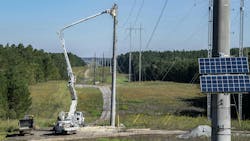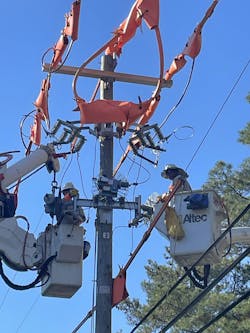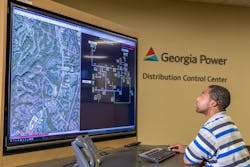Building the Georgia Grid for a Growing State
Georgia Power understands the importance of reliability for every customer and shares a commitment to working safely around the clock, and across the state, to deliver the power that our customers require. As we continue to upgrade our state’s power grid, we’re making purposeful investments using a data-driven approach, and increasingly incorporating automated technology that helps our electric system better respond not only during storms, but every day.
Part of our commitment to building the future of energy is making valuable investments in Georgia’s energy grid to make it stronger and more resilient for our customers. Over the past 10 years, we have invested more than $10 billion in strengthening the power grid through programs and initiatives approved by the Georgia Public Service Commission (PSC). Georgia Power continued this ongoing work on projects throughout Georgia communities in 2023 resulting in a strong year for reliability performance.
Reliability is measured in two ways: frequency of service interruptions, or “System Average Interruption Frequency Index” (SAIFI), and duration of service interruption, or “System Average Interruption Duration Index” (SAIDI). Last year, Georgia Power’s SAIFI score was among the best in the company’s history, with customers experiencing an average of 15% fewer power outages than the previous year. Additionally, when customers did experience power outages, restoration times were approximately 27 minutes faster than the previous year. This duration measurement, or SAIDI value, was one of the best performances in recent years.
Investing in a Stronger Grid
Our grid is stronger and more resilient in part due to our multi-year Grid Investment Program, which has resulted in an up to 50% improvement in reliability for some customers. During the first phase (2020 – 2022) of the multiyear Grid Investment Program, Georgia Power invested approximately $1.4 billion. This investment allowed the company to replace approximately 4,450 transformers, install about 1,450 smart devices, improve more than 20 substations and place over 350 miles of power lines underground, enhancing service for more than a quarter million customers across the state. Phase Two is currently underway beginning in 2023 and continuing through the end of 2025.
The Grid Investment Program targets underperforming circuits and takes the most reasonable approach to improving reliability using a cost-benefit analysis. This analysis determines that a system wide SAIDI score of 80 provided the most reliability improvement for the least cost to our customers, and the Grid Investment Program aims to achieve this. This is important because we keep the customer at center of all we do and that’s one reason why affordability is central to our planning. We work hard to deliver the most reliable service for the lowest total cost to our customers. The program aims to improve our system wide SAIDI while keeping customer bills affordable.
An Eye on the Grid
Throughout the state, Georgia Power analyzes its system of 38,000 miles of distribution lines and 12,000 miles of transmission lines and based on historical outage data and in the case of transmission, the age of the assets, selects the lowest performing circuits and substations for investment. Each specific circuit’s outage data is analyzed to determine the cause of outages, and the type of investment is based on this. For example, if car accidents repeatedly break power poles causing the main source of outages in the area, the investment type might include undergrounding or relocating the pole. The cause of outages on another circuit might show that strengthening the line or adding a smart device would be the best investment to make.
High service reliability in 2023 was driven, in large part, by the continued installation of smart, automated devices throughout the power grid, making it a “self-healing” network. Last year alone, crews installed more than 1,000 automated devices across the state, which can be controlled remotely. This technology allows Georgia Power’s operations team to reroute power and segment a power line, which isolates issues and results in fewer customers affected by an outage, and faster restoration for others.
Our self-healing energy grid provides fault detection sensors and monitoring devices at various points to detect abnormalities and issues on the system. Once a fault is detected, the system pinpoints the location, allowing the system to isolate the issue to prevent the event from spreading further and causing more extensive outages. After isolating the fault, the system automatically restores power to as many customers as possible by rerouting electricity through alternative paths. All of these processes are automated and controlled by advanced algorithms and software systems, minimizing the need for human intervention and speeding up response times.
Boosting Reliability
In addition to installing smart technology, Georgia Power’s ongoing investments in the grid in recent years include upgrading or rebuilding transmission lines and dozens of substations across Georgia for safe and reliable power delivery to homes and businesses; relocation of hundreds of miles of power lines underground, where it made the most impact; and improvement or installation of tens of thousands of power poles. All this infrastructure works together to improve reliability through a stronger and more resilient power grid and helped deliver last year’s high reliability.
Georgia benefits from an integrated transmission system that includes nearly 20,000 miles of high-voltage power lines used by all of this state’s power companies to deliver energy from power generation sources to customers. As our state continues to grow, we’re investing in this system to help keep reliability high for every Georgian year-round.
Working in concert with the transmission and distribution network is Georgia Power’s diverse mix of generation resources, which also plays an essential role in providing reliable electric service to customers. In 2023, our generation fleet helped keep reliability high with experienced teams at hydro, natural gas, nuclear and coal-fired generation plants managing plant operations and maintenance activities at a level of excellence well above industry standards. Non-nuclear generation assets measure reliability with plant outage rate or “equivalent forced outage rate” (EFOR). Last year, Georgia Power’s EFOR score was among the best in company history and among the best in the industry, with an outage rate of 1.49%. We also continue to add renewable energy and battery energy storage to our generation mix, with reliability at the center of our planning process, and our existing solar generation performing strongly as well in 2023.
Additionally, Georgia Power’s focus on reliability is important for businesses that grow and expand in state. Georgia is growing at a rapid pace. Many businesses coming to the state are bringing large electrical demands at both a record scale and velocity. Recent energy projections from Georgia Power reflect energy growth of approximately 6,600 MW through 2031, and that’s up from approximately 400 MW previously forecasted in January 2022.
Georgia on the Grow
We are working with the PSC as we plan to serve the added demand for electricity resulting from Georgia’s strong and growing economy. The state is experiencing new and expanding economic activity across several industries, including automotive, electric transportation manufacturing, technology, clean energy manufacturing (i.e., solar panels), agriculture and aerospace all of which are contributing to the load growth. We plan and build our system to serve our customers with clean, safe, reliable, and affordable energy. We view this as an opportunity for our state to further demonstrate that Georgia is open and ready for business.
Additionally, when extreme heat or cold, like we saw with Winter Storm Heather, drives increased demand for electricity, our Generation teams are at work 24/7 in Georgia’s power plants. We’re proud of the performance of our fleet last year and thank our team for their continued focus on reliability, as well as affordability by keeping production costs as low as possible for customers.
Georgia Power continues to invest in a stronger and more resilient power grid through our successful multi-year Grid Investment Program, which has already resulted in an up to 50% improvement in reliability for some customers, expansion of self-healing networks, industry-leading operations and maintenance of our diverse generating fleet and the successful completion of the first two nuclear units in a generation. As this work progresses, the company aims to deliver even more reliable energy for customers in the coming years.
Editors' Note: Georgia Power is the largest subsidiary of Southern Co., which will host the 2024 T&D World Live Conference and Exhibition on Oct. 1-3, in Atlanta, Georgia. Visit https://events.tdworld.com/2024 to register and check out the technical program.
About the Author
Cleve Fann
Cleve Fann serves as the Vice President of Strategy and Support. In this role, he is responsible for leading the team working directly with strategic development and execution of capital programs, implementing best practices and identifying innovative processes for the grid investment plan, stakeholder engagement, forestry and right-of-way, customer operations, capital governance and budget oversight. Additionally, he is responsible for shaping and overseeing our industry-leading storm center team.




